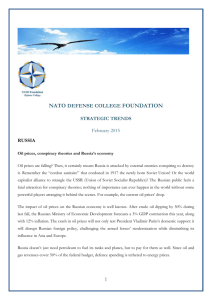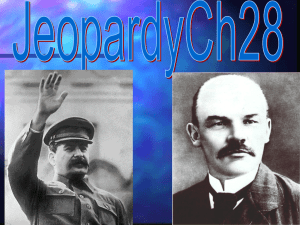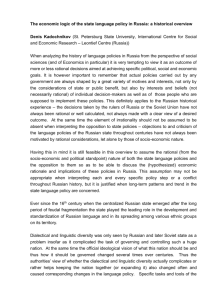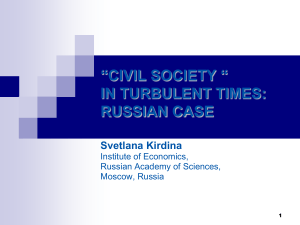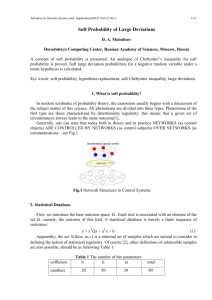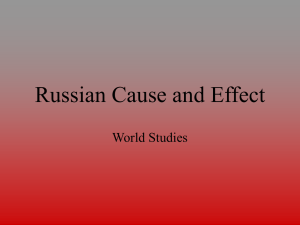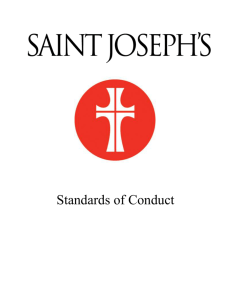What are Russian schools like
advertisement
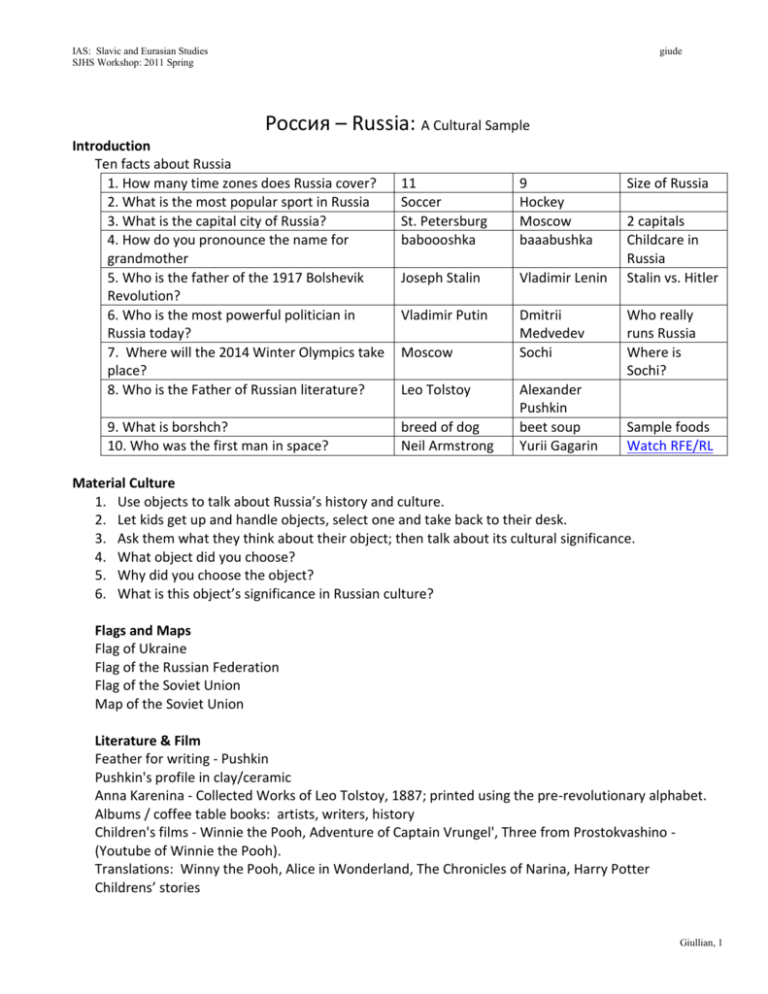
IAS: Slavic and Eurasian Studies SJHS Workshop: 2011 Spring giude Россия – Russia: A Cultural Sample Introduction Ten facts about Russia 1. How many time zones does Russia cover? 2. What is the most popular sport in Russia 3. What is the capital city of Russia? 4. How do you pronounce the name for grandmother 5. Who is the father of the 1917 Bolshevik Revolution? 6. Who is the most powerful politician in Russia today? 7. Where will the 2014 Winter Olympics take place? 8. Who is the Father of Russian literature? 9. What is borshch? 10. Who was the first man in space? 11 Soccer St. Petersburg baboooshka 9 Hockey Moscow baaabushka Joseph Stalin Vladimir Lenin Vladimir Putin Dmitrii Medvedev Sochi Moscow Leo Tolstoy breed of dog Neil Armstrong Alexander Pushkin beet soup Yurii Gagarin Size of Russia 2 capitals Childcare in Russia Stalin vs. Hitler Who really runs Russia Where is Sochi? Sample foods Watch RFE/RL Material Culture 1. Use objects to talk about Russia’s history and culture. 2. Let kids get up and handle objects, select one and take back to their desk. 3. Ask them what they think about their object; then talk about its cultural significance. 4. What object did you choose? 5. Why did you choose the object? 6. What is this object’s significance in Russian culture? Flags and Maps Flag of Ukraine Flag of the Russian Federation Flag of the Soviet Union Map of the Soviet Union Literature & Film Feather for writing - Pushkin Pushkin's profile in clay/ceramic Anna Karenina - Collected Works of Leo Tolstoy, 1887; printed using the pre-revolutionary alphabet. Albums / coffee table books: artists, writers, history Children's films - Winnie the Pooh, Adventure of Captain Vrungel', Three from Prostokvashino (Youtube of Winnie the Pooh). Translations: Winny the Pooh, Alice in Wonderland, The Chronicles of Narina, Harry Potter Childrens’ stories Giullian, 1 IAS: Slavic and Eurasian Studies SJHS Workshop: 2011 Spring giude Coins & Buttons Znachki - pins with insignia Russian and Soviet coins Metro tokens State Emblems of Russia: The Two-headed eagle was originally the emblem of the Roman Empire. It was inherited by Russia through the marriage of the Tsar of all Rus' Ivan the III [not the terrible (groznyi, which should really be translated powerful or imposing, rather than terrible) to hieress of the Byzantine throne, Sofia Paleolog, niece of the last Byzantine Emperor, Constantine XI. It was first used as a state emblem of Russia in 1497 on the seal of Ivan III. The Savior Tower of the MOscow Kremlin was decorated with this emblem at that time. AFte rthe revolution of February 1917 the two-headed eagle lost its crown, sceptre, globe, emblems of principalities. After the October (or Bolshevik) Revolution the the two-headed ealgle was no longer used as a state emblem. Russian calendars Cyrill and Methodius, The Summer Garden The Moscow Kremlin in the 19th century Russia Traditional Culture Fur hats Bast shoes - lapti (lapot') Bast shoes are shoes made primarily from bast - fiber from the bark of the linden tree or birch tree: they are a kind of basket woven and fitted to the shape of a foot. Bast shoes are an obsolete traditional footwear of forest areas of Eastern Europe, formerly worn by poorer members of the Finnic peoples, Balts, and Slavs. They were easy to manufacture, but not very durable. Bast shoes have been worn since prehistoric times: wooden foot-shaped blocks (lasts) for shaping them have been found in neolithic excavations. Bast shoes were still worn in the Russian countryside at the beginning of the 20th century. Today bast shoes are sold as souvenirs and sometimes worn by ethnographic music or dance troupes as part of their costumes. Lubok depicting a peasant making lapti (Russian bast shoes).In Russian, they are called lapti (лапти, sing. лапоть, lapot'); this word is used as a derogatory term for cheap and short-lived footwear and also for uneducated people (лапотник, lapotnik: one who is too poor to afford good shoes and wears bast shoes instead). http://en.wikipedia.org/wiki/Bast_shoe Balalaika - traditional Russian folk instrument (play Moscow nights, listen to song on Youtube) Matrioshka - nesting doll; imported from the East (China/Japan?) - traditional doll (mass produced Soviet style using decals; after 1991, artists new designs exploded as the matrioshka became a popular tourist souvenir; they became fancier, with all kinds of designs (highly decorated, Russian and Soviet leaders, Orthodox churches and cathedrals; family photos, and eaven KU basketball team. It was possible to commission artists to paint whatever you wanted - we should have commissioned on of all the KU Jayhawks. Russian folk toys - bear and peasant hammering on the anvil, pop-gun with a bear handle, Baba Iaga's hut on chicken legs with the three-headed dragon (show scenes from Rou's film). Pisanky - decorated eggs (mine are made of wood): a Ukrainian tradition - video on You-Tube) Giullian, 2 IAS: Slavic and Eurasian Studies SJHS Workshop: 2011 Spring giude Firebird bowl, Folktales, Samovar, Folk doll Embroidered table runners Flowered scarves (black, blue, red) Lacquer boxes. Soviet cards done in the style of the Palekh art (black lacquer boxes). While the lacquer box has roots that go back deep in time, the unique Russian tradition has flowered in the twentieth century. Art and craft historians place great emphasis on the influence of the Russian Revolution in making names such as Palekh, Mstiora, Kholui and Fedoskino well known to collector of fine miniature painting. These are the names of small, yet cultually important villages within the "Golden Ring" that surrounds Moscow. In those places there once existed well established traditions or "schools" of icon painting. After 1917, when religious art officially fell "out of fashion" the craftsmen turned their attention to the creation of miniatures with classic secular themes (i.e romantic love, national folklore, folk life and public events). Qith each village retaining its unique artistic style in the representations. http://www.hudson-neva.com/LacquerBoxes/about.htm http://www.artrusse.ca/index_en.htm http://www.thimble.h11.ru/firm1.html Language and Literature 1. Listen to Winnie the Pooh in Russian 2. Poetry in Russia is a big deal! a. Poets as artists, social critics, and even prophets, b. Poetry is alive and well: school programs; Умом Россию не понять, Аршином общим не измерить: У ней особенная стать — В Россию можно только верить. --ТЮТЧЕВ, Фёдор Иванович (1803—73) Student activity: transliterate and translate Tiutchev’s poem Handouts student worksheet and transliteration table Explain transliteration and do the first line together. Translate using vocabulary list: What is Tiutchev trying to express? Russian умом не понять Аршином общим измерить y ней English by the mind not to understand ruler standard to measure she has Russian особенная стать в можно только верить English particular character, personality in, into it is possible, one can only to believe Giullian, 3 IAS: Slavic and Eurasian Studies SJHS Workshop: 2011 Spring giude Sample of Music For each group fill in the table below Name of musician/group Genre Similar to ? 1. Folk Music 2. Classical Music: What do Russia, Christmas, and the 4th of July have in common? a. How many of you go to the 4th of July concert at South Park? What is your favorite part? b. Play samples from the Nutcracker and the 1812th overture. c. In 1880, Tchaikovsky was commissioned to compose a work for the consecration of the Cathedral of Christ the Savior, a Moscow Orthodox cathedral built in honor of the 70th anniversary of Russia's defeat of Napoleon. Roll out the "1812 Overture," a symphony where the French anthem, Russian Czarist hymns and Orthodox liturgical music do battle. Tchaikovsky saw it as a work-for-hire, not a labor of love. Even while working on it, he dismissed it as "very noisy and loud." But that's what made it a Fourth of July hit. The symphony -- which was introduced to pop culture in the 1960s, thanks to a cereal commercial -- exploded in popularity in 1974, when Arthur Fiedler led the Boston Pops through a nationally televised Independence Day performance.The Russian ode, with its cannons and grand finale, became an American anthem with numerous ensembles, including the Cleveland Orchestra -- which first performed the work in 1924 on its debut recording. Tchaikovsky's occupation of America grew even more insidious when it appeared in "Caddyshack," "The Bad News Bears in Breaking Training" and "The Simpsons" (from an article by John Petkovic, Plain Dealer Reporter, July 2, 2007). 3. Russian Bards 4. Russian Classic Rock 5. Russian Pop 6. Far From Moscow Giullian, 4

